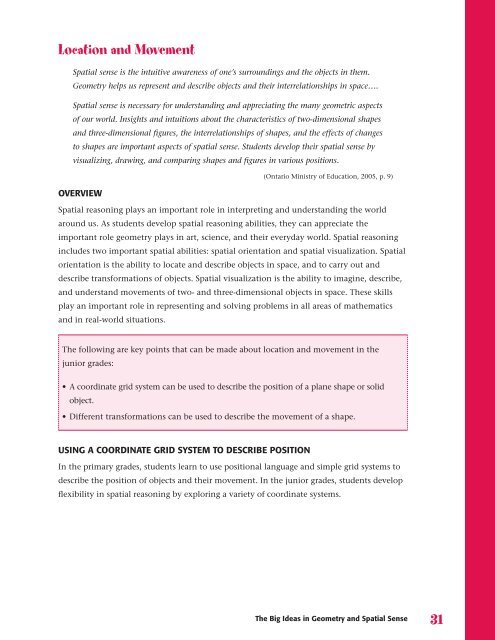Geometry and Spatial Sense, Grades 4 to 6 - EduGains
Geometry and Spatial Sense, Grades 4 to 6 - EduGains
Geometry and Spatial Sense, Grades 4 to 6 - EduGains
You also want an ePaper? Increase the reach of your titles
YUMPU automatically turns print PDFs into web optimized ePapers that Google loves.
Location <strong>and</strong> Movement<br />
<strong>Spatial</strong> sense is the intuitive awareness of one’s surroundings <strong>and</strong> the objects in them.<br />
<strong>Geometry</strong> helps us represent <strong>and</strong> describe objects <strong>and</strong> their interrelationships in space….<br />
<strong>Spatial</strong> sense is necessary for underst<strong>and</strong>ing <strong>and</strong> appreciating the many geometric aspects<br />
of our world. Insights <strong>and</strong> intuitions about the characteristics of two-dimensional shapes<br />
<strong>and</strong> three-dimensional figures, the interrelationships of shapes, <strong>and</strong> the effects of changes<br />
<strong>to</strong> shapes are important aspects of spatial sense. Students develop their spatial sense by<br />
visualizing, drawing, <strong>and</strong> comparing shapes <strong>and</strong> figures in various positions.<br />
OVERVIEW<br />
(Ontario Ministry of Education, 2005, p. 9)<br />
<strong>Spatial</strong> reasoning plays an important role in interpreting <strong>and</strong> underst<strong>and</strong>ing the world<br />
around us. As students develop spatial reasoning abilities, they can appreciate the<br />
important role geometry plays in art, science, <strong>and</strong> their everyday world. <strong>Spatial</strong> reasoning<br />
includes two important spatial abilities: spatial orientation <strong>and</strong> spatial visualization. <strong>Spatial</strong><br />
orientation is the ability <strong>to</strong> locate <strong>and</strong> describe objects in space, <strong>and</strong> <strong>to</strong> carry out <strong>and</strong><br />
describe transformations of objects. <strong>Spatial</strong> visualization is the ability <strong>to</strong> imagine, describe,<br />
<strong>and</strong> underst<strong>and</strong> movements of two- <strong>and</strong> three-dimensional objects in space. These skills<br />
play an important role in representing <strong>and</strong> solving problems in all areas of mathematics<br />
<strong>and</strong> in real-world situations.<br />
The following are key points that can be made about location <strong>and</strong> movement in the<br />
junior grades:<br />
• A coordinate grid system can be used <strong>to</strong> describe the position of a plane shape or solid<br />
object.<br />
• Different transformations can be used <strong>to</strong> describe the movement of a shape.<br />
USING A COORDINATE GRID SYSTEM TO DESCRIBE POSITION<br />
In the primary grades, students learn <strong>to</strong> use positional language <strong>and</strong> simple grid systems <strong>to</strong><br />
describe the position of objects <strong>and</strong> their movement. In the junior grades, students develop<br />
flexibility in spatial reasoning by exploring a variety of coordinate systems.<br />
The Big Ideas in <strong>Geometry</strong> <strong>and</strong> <strong>Spatial</strong> <strong>Sense</strong> 1

















